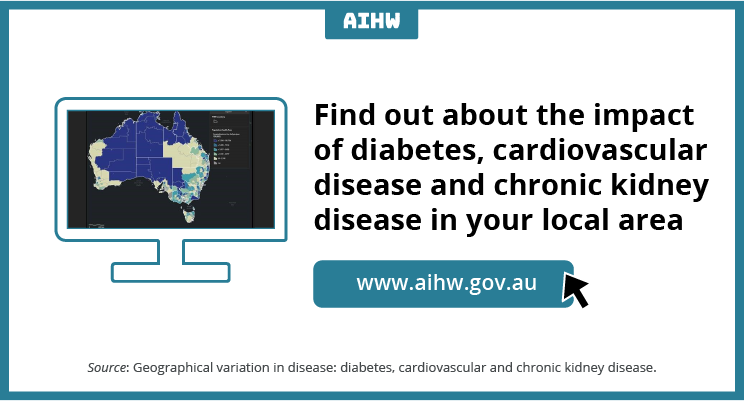Explore geographical variation in disease: diabetes, cardiovascular and chronic kidney disease
The article was originally posted on LinkedIn by Miriam Lum On, Cardiovascular, Diabetes & Kidney, Unit Head, AIHW.

I’m excited to see my team’s report Geographical variation in disease: diabetes, cardiovascular and chronic kidney disease published today. Arising from a super team effort, the report represents AIHW’s largest mapping product to date, with 36 dynamic dashboards and 108 maps showing the distribution of the impact of type 2 diabetes, cardiovascular and chronic kidney disease (including acute kidney injury (AKI) and dialysis).
Users can explore disease prevalence, hospitalisation and death rates by 3 geographical levels: state/territory, Primary Health Network (PHN) and Population Health Area (PHA). The dashboards also contain statistics on the local health profile and selected population characteristics to provide additional insight into the factors influencing health outcomes.
The report highlights key findings summarising the variation of the disease measures by geographic area. For instance:
- by PHN, the proportion of adults with type 2 diabetes ranged from 3.8% to 8.1%. Overall, age adjusted rates were higher in regional than in metropolitan areas.
- by PHA, CVD hospitalisation rates ranged from 197 to 6,200 per 100,000 population. PHAs with the highest age-adjusted rates were generally located in remote areas and displayed less favourable health profiles than the national average.

Explore the full product suite:
Our next report, scheduled for late September, Heart, stroke and vascular disease: Australian facts, will provide the latest available data describing cardiovascular disease in the Australian population. This report will include information on risk factors, comorbidities, treatment, management and impact, in terms of burden of disease estimates and health expenditure.
Finally, I just want to thank my team, the Cardiovascular, Diabetes and Kidney Unit at the AIHW for such an inspiring effort to bring to life such a complex and important data set that will help health policy makers and planners to understand their local populations.


